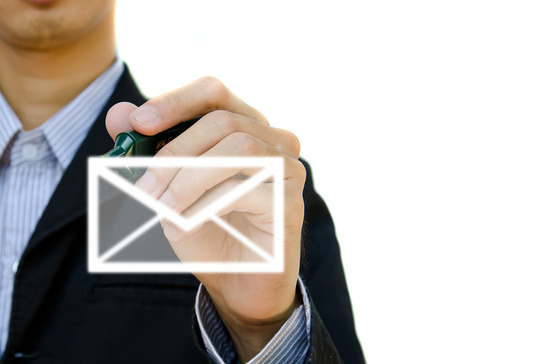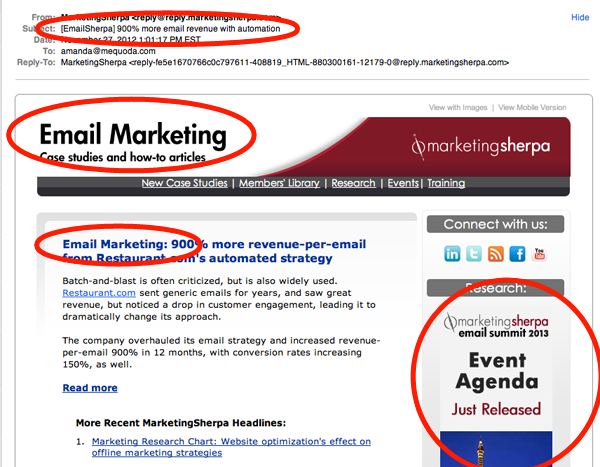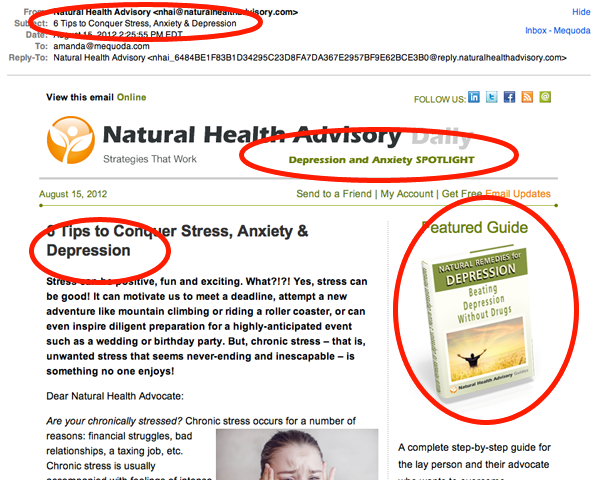Components all email newsletter templates should share
We’ve discovered that the best performing email newsletters — those with the highest value, as measured by producing the highest revenue per thousand — reflect a total alignment between the subject line, headline, subhead, body copy, embedded text ads, display ads, and the featured product.
This is true whether the newsletter is sponsored by an advertiser who buys your leader board, or whether the newsletter promotes your own products. Most Mequoda System Publishers use their free email newsletters to promote their own paid products.
We believe in single-topic email newsletters in which every component is aligned around the same theme. The exception is the Week-in-Review email for your subscribers who prefer to be contacted only once a week.
When reading an email newsletter, the reader responds most favorably to both text ads and displays ads when there’s contextual alignment with the topic.
A best practice email is wholly contextual. There’s alignment between the subject line, headline, subhead, body copy, and the featured product ads. All the core elements are aligned around the same topic.
This congruency is comforting and harmonizing. It appears to have a subliminal effect on readers.
The curiosity that’s stimulated by the email subject line, which prompted the user to open your email newsletter, should be amplified by the inside headline and sub-headline, then satisfied by the text. The contextual text ads provide an opportunity for the reader to take the next step by visiting your website and buying your product.
All these elements augur well for a satisfying, information-laden transaction that seamlessly guides the user up your product pyramid to a paid product or service.
Let’s take a look at some examples of email newsletter templates in practice:
MarketingSherpa sends a blast out to their list of email marketing enthusiasts and professionals. It let’s them know the email is about email marketing, the article is about email marketing, and the ad for their email marketing event.

[text_ad]
Natural Health Advisory uses a Depression and Anxiety Spotlight email that readers choose to subscribe to, and their subject line, masthead, article title and featured product all reflect the same topic of Depression.

Maximizing tightly-focused mono-topic email newsletter templates
On average, 68% of product sales start with an email newsletter. If you’re a medical publisher sending an email newsletter about “heart health”, your featured product should be a report about “how to avoid a heart attack”, or the like. The same goes for ad-driven publishers; the content in your email newsletter must match the sponsor or sponsored links in order to get the best click-through or conversion rate.
In this type of email newsletter template, there’s only one article as opposed to several. This email newsletter (in addition to providing valuable content) has the functional goal of driving subscribers to a sales letter landing page.
This isn’t to say that mono topic emails are only for product-driven publishing companies. Many ad-driven publishers have dedicated sponsors for their mono topic emails, and some have a mix of sponsored ads and product ads.
Mono tip email newsletter templates are best used when your blog update schedule matches your email delivery schedule.
A few mono topic best practices for email newsletter templates:
- Users love alignment. Don’t try to increase open rates by using a subject line that’s more creative than the article title. Make sure that the title of your email matches the title of the article to avoid confusion. In fact, if your email subject line is so catchy, why isn’t it your blog titled the same?
- Keep them in one place. Users prefer full content rather than clicking out to a website to finish the article. When they eventually click, the goal should be to get them to your sales letter landing page or sponsor. If you have graphics, it makes sense to point your users back to the blog, but include the full text of the article in the email with a link to view examples and graphics.
- Make ads relevant. No matter whether you’re product or ad-driven, keep your product or sponsor limited to the same topic. If you’re writing an article on knitting, promote a book on knitting, not beading. If you’re writing an article on cars that get the best MPG, use a sponsor like Toyota with a Prius ad, not a Hummer ad.
- Promote one thing, not several. When you’re ad-driven, this can be tricky because you have many sponsors. Try having one sponsor per topic email and offering them ad spots at the top, side and bottom of the email. This cleans up your emails for our users and makes your sponsor happy too.
How are you delivering your content? Are providing your users an email newsletter as a service while still driving traffic and increasing RPM?


